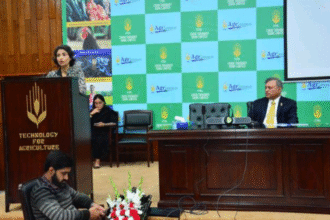
By: Rizwan Tahir Chohan
Ranked among the most climate-vulnerable countries, Pakistan is currently experiencing one of the most severe heat waves in recent years, with temperature becoming unbearable for humans and ecosystems in mostly southern and western parts of the country.
The warmer temperatures have spiked above 48°C in several cities across the country, affecting millions of people. Even the capital city, Islamabad, which is known for usually pleasant weather due to its greenery and elevation, has not been spared in recent years. The ongoing heat wave has pushed temperatures to unusually high levels in the city, once again highlighting how climate change is impacting all regions of Pakistan- urban and rural alike.
A heat wave is a prolonged period of excessively hot weather, often accompanied by high humidity. During a heat wave, the human body struggles to regulate its internal temperature, which can lead to a range of heat-related illnesses.
This persistent heat wave has made daily life for millions, mostly those without access to cooling and clean drinking water, extremely difficult. Across the country, schools have been closed this summer earlier than usual to protect children from the harsh weather.
Electricity demand has surged due to the increased use of fans and air conditioners, leading to prolonged load-shedding. Many cities are also facing water shortages, further adding to the public’s suffering. Health experts have warned that the extreme heat is dangerous for everyone, especially children, the elderly, and outdoor workers. Hospitals have reported a rise in cases of heatstroke and dehydration. The health department has advised people to stay indoors during peak heat hours and to avoid unnecessary outdoor activities.
But, unfortunately, many low-income individuals who rely on daily wages cannot afford to stay at home. Laborers, traffic police, journalists, and delivery riders are most at risk, and many are being treated for heat-related illnesses.
To stay safe during the ongoing heat wave, it is important for everyone to take individual precautions. People should try to remain indoors during the hottest part of the day, usually between 11 AM and 4 PM. Drinking plenty of water throughout the day is essential, even if one does not feel thirsty.
In addition, wearing light-colored, loose-fitting clothes can help keep the body cool. Using wet towels, fans, or taking cool showers is also effective in lowering body temperature. It is advised to avoid heavy meals and to stay away from caffeinated or sugary drinks, as they can contribute to dehydration.
Children and elderly individuals should never be left alone in parked vehicles, as the temperature inside can rise dangerously fast. Besides, everyone should remain alert for symptoms of heatstroke, such as headache, dizziness, and nausea, and seek medical attention if these signs appear. Checking on elderly and sick individuals is also a responsible and caring step to ensure community safety during this extreme weather.
Climate experts believe that such heat waves are no longer rare occurrences and have already become new normal. Because, these heat wave have become now more frequent and intense due to climate change in Pakistan. Rising global temperatures, deforestation, and rapid urbanization are making cities hotter and less breathable.
According to scientists, Pakistan is among the top 10 countries most affected by climate change, even though it contributes less than 1% to global greenhouse gas emissions. The country is now facing the serious consequences of a warming planet—from floods and droughts to recurring heat waves.
The National Disaster Management Authority (NDMA) is actively responding to the growing threat of heat waves. To tackle this challenge, NDMA has introduced the Heatwave Action Plan 2024 and the Summer Hazards Contingency Plan 2025. These plans focus on proactive measures such as launching public awareness campaigns, setting up heatstroke treatment centers, and preparing emergency response protocols in collaboration with provincial and local authorities. The aim is to reduce health risks, improve preparedness, and ensure timely responses during periods of extreme heat.
Pakistan needs a clear and robust national strategy to deal with heat waves and other climate threats. Planting more trees, improving public transport, creating green spaces, and educating people about heat safety should be key components of this plan. The current heat wave serves as a serious warning. If Pakistan does not act now, such extreme weather events will become even more common in the future. This is not just a seasonal concern—it is a national emergency that demands immediate attention and long-term commitment from both the government and the public.
According to the Ministry of Climate Change in Islamabad, spokesperson Mohammad Saleem Shaikh stated that Federal Minister Musadik Masood Malik has taken notice of the situation and is working closely with provincial governments. The ministry has urged local authorities to implement heat action plans and establish emergency response units. It has also issued public advisories on staying safe during the heat wave. Besides,, the ministry is focusing on long-term solutions such as tree plantation, climate education, and improved urban planning to make cities more climate-resilient. However, many experts argue that these efforts require stronger implementation and greater urgency.





